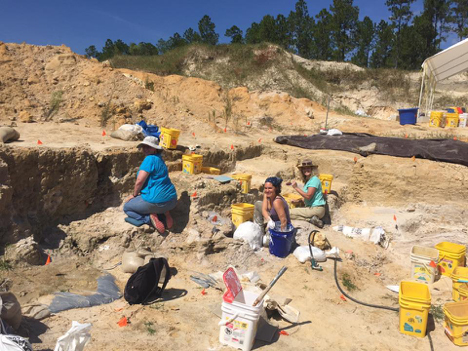by Alex Lounders
For some backstory on this fossil as it was originally given to me–this specimen was originally thought to be a series of 6 articulated otter tail vertebrae from a 5 million-year-old site near Williston, Florida. A previous volunteer left this specimen roughly a quarter of the way through its prepping process, leaving it partially exposed outside of its plaster jacket. I’ve learned that it is not uncommon for museums to have a backlog of fossil finds to be prepared. Lack of funding and people to do the work is a perennial problem in case there are any fossil philanthropists out there that may happen to be reading this. Back to the otter specimen, this particular fossil is also a contender to be one of the oldest recorded otter fossils ever discovered in North America. So a certain degree of caution and precision was needed to fully prepare and extract the fossil from the dirt in one piece.
As the specimen’s top half was already polished and showing plenty of bone, my first task was to carve around any exposed sections in the hopes of finding any other pieces that happened to be further below. After that, I had to flip the fossil over in a sand box and work through roughly 2 inches of sand on its opposite face. Two important factors for this section included the sand pit which cradled the exposed bone to keep it intact, and the slow process of digging through the opposite side’s layer of sand. While the fossil did not appear to reach that far down, and simply ripping off large chunks of sand would have been faster, it was still possible that some pieces had shifted away from the main body. Digging through all this sand required more than a dental tool, as it was soaked with a B-72 glue to keep everything in place. A brush of acetone made quick work of the glue and easily swept the sand away.


After both sides were much more visible, it came time to bring the fossil under the careful scrutiny of a microscope. Using a microscope made distinguishing sand from bone much easier and made the tedium of wiping away grains of sand less tedious. The magnification made each brush stroke reshape mountains. After an extended period of microscopic fine detail work, the fossil was given a candy coating of B-72 to keep everything in place and then taken to one of the supervisors of the vertebrate paleontology department. Upon seeing the specimen, the supervisor let out a dismayed groan in shocked horror! Quickly explained, the vertebrae were not actually part of the tail as originally thought. The set contained the axis vertebrae which rests very close to the skull. It was an incredible shame that the skull was not found with the rest of this fossil, which explained the supervisor’s dismay. Even so, the fossil still proved to be a fine specimen. Through comparison with modern otter vertebra, we were able to confirm the identity as the genus Lontra.
|
|
 |
More information from Rachel Narducci, volunteer coordinator at the Montbrook site and a fossil preparator at FLMNH:

The specimen was discovered by a former UF graduate student on October 11, 2016 at the Montbrook Fossil Locality in Levy County, Florida.
The site is set up as a 1 meter by 1 meter square grid system. The preservation in this particular square is abnormal compared to the remainder of the site. The layers dip steeply towards the north with a hard limestone/sand concretion, underlain by thin layers of thick black mud and white sand. This square also produced a large portion of the swan and both species of otter (Lontra sp. and Enhydritherium terraenovae) fossils discovered throughout the site.
The specimen was discovered two days after this picture was taken in the square to the right of the woman in the green shirt, volunteer Cindy Lockner. Also pictured are student Natasha Vitek and volunteer Kara Ericson in the blue shirt.
To learn more:
Read about the Montbrook site here.
